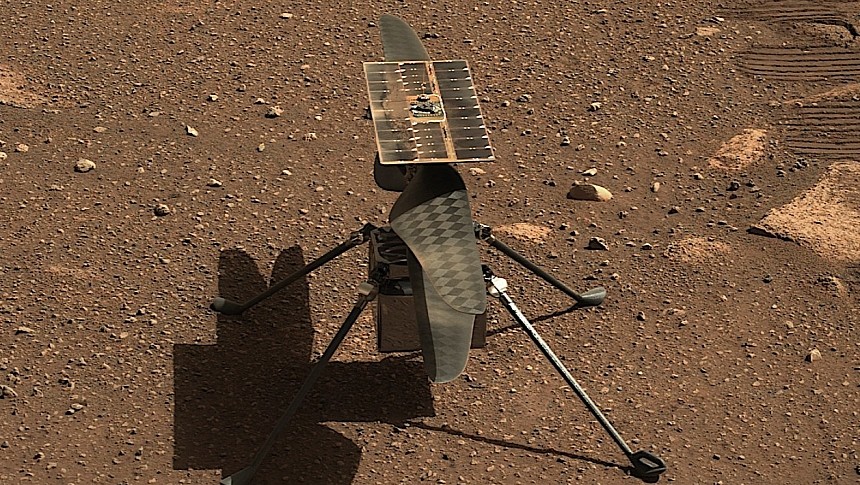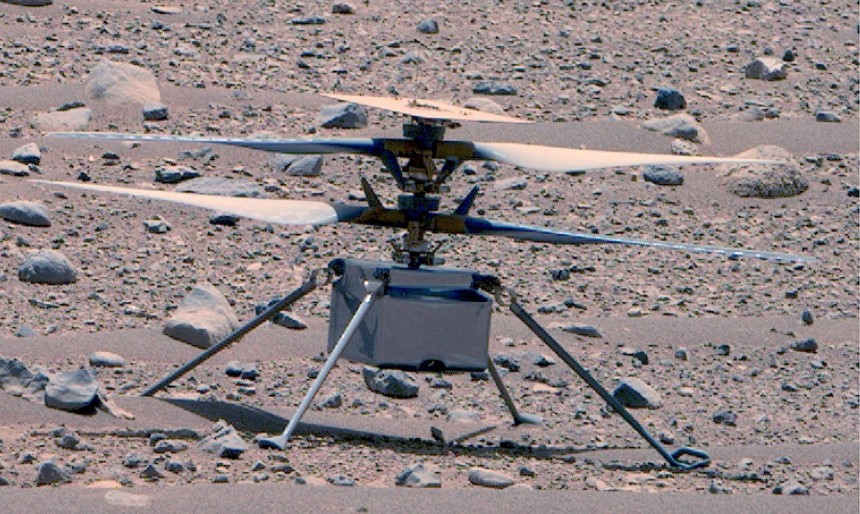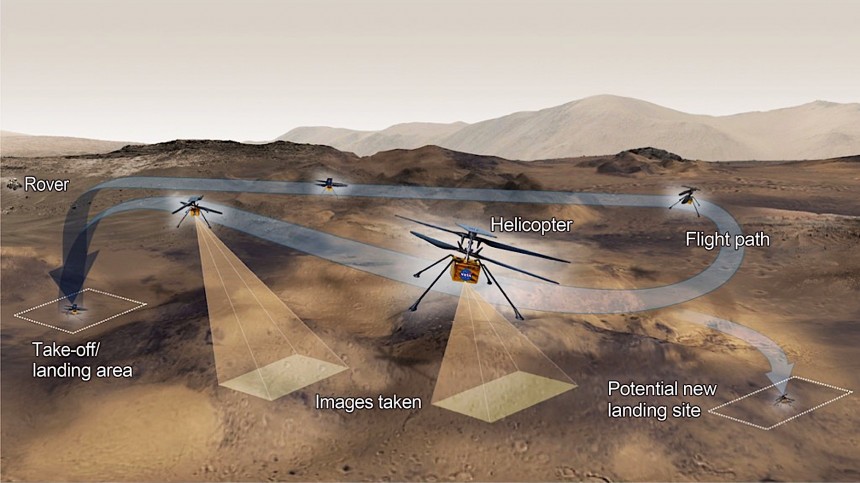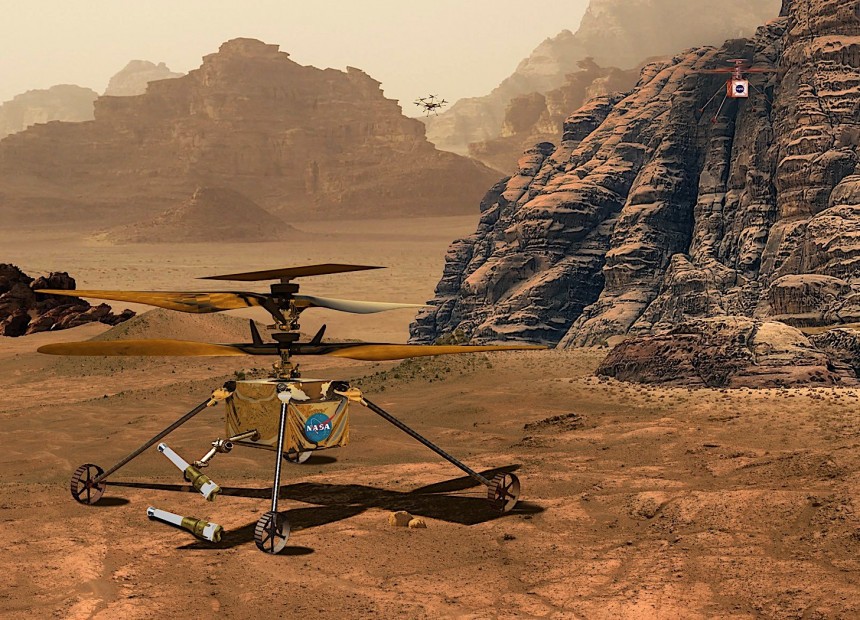When it comes to the exploration of other planets, the best we can do with our current level of technological development is to rely on robots of various shapes, sizes, and purposes. Until about a couple of years ago that meant solely orbiters, landers, and rovers. The arrival of the Perseverance rover and the Ingenuity helicopter on Mars changed all that.
For the first time in the history of our species, a human-made aircraft took to the skies of another world, proving once and for all that sustained flight of a mechanical device in the atmosphere of an alien planet, be it as thin as that of Mars, is possible.
Studying planets using orbiters, landers, and rovers is something that has successfully been performed multiple times, but as we all know, you can't really get a sense of a place until you see it from above. With height comes perspective and insight, and that's exactly what NASA was gunning for with the Ingenuity.
The tiny drone-like contraption (it's just 4 feet /1.2 meters long and weighs 4 pounds / 1.8 kg) was delivered to Mars together with the Perseverance rover back in February 2021, and it was supposed to be operational for just five flights and a single month.
Like several other pieces of hardware we've sent up there over the years, it outlived anyone's expectations, and to date records show almost three years of operation, and a total of 66 flights over the Martian surface.
The success of the helicopter has prompted NASA to begin work on new and more capable designs that could be used in future missions. The upcoming Mars Sample Return, scheduled for later this decade, has a big chance of being the first to use possibly a fleet of helicopters to achieve its goals.
To be able to do that NASA is conducting test flights of aircraft designs, for the first time in human history, on two different planets. These procedures may not be part of the same development program, but it's clear what rocket scientists learn in one place can be used to inform and advance the work on the other.
We'll start with what's happening over on Mars, the perfect testing ground for other-worldly machines due to the "whisper-thin atmosphere and significantly less gravity."
Up there Ingenuity's test flights are accelerating and growing in scope as teams learn more and more about what it can do in the distinct conditions there: the thing can now go faster and higher than ever before, climb and accelerate faster, and land slower than it ever could.
All of this will help gather "invaluable data that can be used by mission designers for future Mars helicopters." Here's how.
A higher altitude for future Martian aircraft will allow for better vantage points in future missions - the highest Ingenuity was able to climb, during Flight 61, was 78.7 feet (24 meters).
A higher speed, on the other hand, will mean more ground could be covered faster. The fastest the current helicopter was capable of going was 22.3 mph (36 mph), during Flight 62.
When it comes to landing, the helo was built to come down pretty fast, at 2.2 mph (3.5 kph). During Flights 57, 58, and 59, NASA managed to slow that down by 25 percent by giving the helicopter a whirl. Slowing the landing speed down would mean a lighter landing gear fitted on upcoming designs.
The above are not the limits of the helicopter, but are the limits the teams controlling it from here on Earth don't really dare cross. NASA says "flying too fast can confuse the onboard navigation system." That's because the helicopter gets its bearings by using a camera, and moving too fast will likely generate fuzzy images that could spell doom for the mission.
Because of the available energy for each flight, but also when taking into account motor temperature, NASA has so far kept Ingenuity's flight short, no more than three minutes.
Meanwhile, here on Earth NASA has already begun working on the bits and pieces that will go into future Martian helicopters. More to the point, the focus now falls on a new kind of rotor, currently being put through its paces at the Jet Propulsion Laboratory.
Made of carbon fiber, the new rotor is four inches (10 cm) longer than the ones fitted on the Ingenuity, comes with a greater strength, and in a different design. It's a solution NASA hopes "could enable bigger, more capable Mars helicopters."
At the time of writing the space agency is looking to find ways around the vibration caused by turbulence when the blade tips get near supersonic speeds. Mach 0.95 was the fastest the blade spun during testing, with the rotor going as fast as 3,500 rpm. That's 750 rpm faster than what the helicopter currently on Mars is capable of doing.
A workaround may come from all the way on Mars, where Ingenuity will perform high-speed pitch-and-roll manures at various angles this December.
Even in its current state, the new helicopter rotor has moved from being a hypothetical exercise to a "ready to fly" status, as per Tyler Del Sesto, Sample Recovery Helicopter deputy test conductor at JPL.
If successful, the current NASA program will give birth first and foremost to the so-called Sample Recovery Helicopters. Two of them will likely be sent to Mars with the Sample Recovery mission to aid with the retrieval of the samples the Perseverance rover has been gathering on the Red Planet.
Studying planets using orbiters, landers, and rovers is something that has successfully been performed multiple times, but as we all know, you can't really get a sense of a place until you see it from above. With height comes perspective and insight, and that's exactly what NASA was gunning for with the Ingenuity.
The tiny drone-like contraption (it's just 4 feet /1.2 meters long and weighs 4 pounds / 1.8 kg) was delivered to Mars together with the Perseverance rover back in February 2021, and it was supposed to be operational for just five flights and a single month.
Like several other pieces of hardware we've sent up there over the years, it outlived anyone's expectations, and to date records show almost three years of operation, and a total of 66 flights over the Martian surface.
The success of the helicopter has prompted NASA to begin work on new and more capable designs that could be used in future missions. The upcoming Mars Sample Return, scheduled for later this decade, has a big chance of being the first to use possibly a fleet of helicopters to achieve its goals.
We'll start with what's happening over on Mars, the perfect testing ground for other-worldly machines due to the "whisper-thin atmosphere and significantly less gravity."
Up there Ingenuity's test flights are accelerating and growing in scope as teams learn more and more about what it can do in the distinct conditions there: the thing can now go faster and higher than ever before, climb and accelerate faster, and land slower than it ever could.
All of this will help gather "invaluable data that can be used by mission designers for future Mars helicopters." Here's how.
A higher altitude for future Martian aircraft will allow for better vantage points in future missions - the highest Ingenuity was able to climb, during Flight 61, was 78.7 feet (24 meters).
When it comes to landing, the helo was built to come down pretty fast, at 2.2 mph (3.5 kph). During Flights 57, 58, and 59, NASA managed to slow that down by 25 percent by giving the helicopter a whirl. Slowing the landing speed down would mean a lighter landing gear fitted on upcoming designs.
The above are not the limits of the helicopter, but are the limits the teams controlling it from here on Earth don't really dare cross. NASA says "flying too fast can confuse the onboard navigation system." That's because the helicopter gets its bearings by using a camera, and moving too fast will likely generate fuzzy images that could spell doom for the mission.
Because of the available energy for each flight, but also when taking into account motor temperature, NASA has so far kept Ingenuity's flight short, no more than three minutes.
Meanwhile, here on Earth NASA has already begun working on the bits and pieces that will go into future Martian helicopters. More to the point, the focus now falls on a new kind of rotor, currently being put through its paces at the Jet Propulsion Laboratory.
At the time of writing the space agency is looking to find ways around the vibration caused by turbulence when the blade tips get near supersonic speeds. Mach 0.95 was the fastest the blade spun during testing, with the rotor going as fast as 3,500 rpm. That's 750 rpm faster than what the helicopter currently on Mars is capable of doing.
A workaround may come from all the way on Mars, where Ingenuity will perform high-speed pitch-and-roll manures at various angles this December.
Even in its current state, the new helicopter rotor has moved from being a hypothetical exercise to a "ready to fly" status, as per Tyler Del Sesto, Sample Recovery Helicopter deputy test conductor at JPL.
If successful, the current NASA program will give birth first and foremost to the so-called Sample Recovery Helicopters. Two of them will likely be sent to Mars with the Sample Recovery mission to aid with the retrieval of the samples the Perseverance rover has been gathering on the Red Planet.












